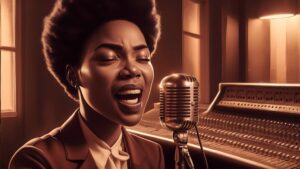10 Best Budget-Friendly Voiceover Home Studio Equipment Options
In today’s fast-paced digital world, having a versatile voiceover home studio setup is essential for any aspiring or professional voice actor.
Whether you’re just starting or looking to upgrade your existing equipment, investing in the right voiceover home studio equipment can make a significant difference in the quality of your recordings and the range of projects you can take on.
To help you navigate the vast array of options available, we’ve compiled a list of the 10 best voiceover home studio equipment items that offer the versatility needed to tackle any project that comes your way.
From microphones and audio interfaces to acoustic treatments and software, these essential tools will help you create professional-grade recordings from the comfort of your own home.
We strongly recommend that you check out our guide on how to take advantage of AI in today’s passive income economy.
Table of Contents
The Foundation of Your Voiceover Home Studio: Microphones
1. Shure SM7B Dynamic Microphone
The Shure SM7B is a legendary dynamic microphone that has been a staple in professional recording studios for decades.
Known for its smooth, warm sound and excellent rejection of background noise, the SM7B is an ideal choice for voiceover artists who want to achieve a broadcast-quality sound in their home studio.
Its rugged construction and ability to handle high sound pressure levels make it a versatile option for recording everything from intimate narration to high-energy commercial spots.
When paired with a quality preamp or audio interface, the Shure SM7B is an essential piece of voiceover home studio equipment that can help you deliver exceptional results every time.
2. Neumann TLM 103 Condenser Microphone
For voiceover artists who prefer the detailed, airy sound of a condenser microphone, the Neumann TLM 103 is an excellent choice.
This large-diaphragm condenser mic is known for its exceptional clarity, transparency, and ability to capture the nuances of the human voice.
Its low self-noise and high SPL handling make it suitable for a wide range of voiceover applications, from soft-spoken narration to high-energy character voices.
The TLM 103’s cardioid polar pattern helps to minimize background noise and room reflections, ensuring that your recordings remain focused on your voice.
As a key component of any versatile voiceover home studio equipment setup, the Neumann TLM 103 is an investment that will pay dividends for years to come.
3. Audio-Technica AT2035 Condenser Microphone
For those working with a tighter budget, the Audio-Technica AT2035 is a fantastic alternative to more expensive condenser microphones.
This large-diaphragm condenser mic offers a warm, clear sound that is well-suited to voiceover work, with a wide dynamic range and low self-noise.
Its cardioid polar pattern helps to isolate your voice from unwanted room noise, while its high SPL handling ensures that it can capture even the most dynamic performances without distortion.
The AT2035 also features a switchable 80Hz high-pass filter and 10dB pad, giving you additional control over your sound.
As a versatile and affordable option for your voiceover home studio equipment arsenal, the Audio-Technica AT2035 is hard to beat.
Bringing It All Together: Audio Interfaces and Software
4. Focusrite Scarlett 2i2 USB Audio Interface
To connect your microphone to your computer and record your voiceover performances, you’ll need a quality audio interface.
The Focusrite Scarlett 2i2 is a popular choice among voiceover artists, thanks to its excellent sound quality, intuitive controls, and affordable price point.
This USB audio interface features two high-quality microphone preamps with plenty of gain, allowing you to record clean, professional-sounding vocals without the need for additional equipment.
Its low-latency monitoring capabilities and direct monitor control make it easy to hear your performance in real-time, ensuring that you can deliver your best take every time.
As a core component of any versatile voiceover home studio equipment setup, the Focusrite Scarlett 2i2 is an excellent investment.
5. Universal Audio Apollo Twin MKII Audio Interface
For voiceover artists who demand the highest quality audio and the ability to shape their sound with industry-standard plug-ins, the Universal Audio Apollo Twin MKII is the ultimate audio interface.
This powerful desktop interface features two high-quality microphone preamps, as well as UAD-2 DSP processing for running UAD plug-ins in real-time with near-zero latency.
The Apollo Twin MKII also includes a range of classic analog emulations, allowing you to add warmth, character, and depth to your voiceover recordings.
Its intuitive control panel and compatibility with both Mac and Windows systems make it a versatile choice for any voiceover home studio equipment setup.
While it may be a more significant investment than some other audio interfaces, the Universal Audio Apollo Twin MKII’s exceptional sound quality and powerful features make it a worthwhile choice for serious voiceover professionals.
6. Adobe Audition
When it comes to voiceover recording and editing software, Adobe Audition is a top choice for many professionals.
This powerful digital audio workstation offers a comprehensive set of tools for recording, editing, mixing, and mastering your voiceover projects.
Its intuitive interface and extensive feature set make it easy to create professional-grade recordings, even if you’re new to audio production.
Adobe Audition’s noise reduction and restoration tools are particularly useful for voiceover artists, allowing you to clean up any unwanted background noise or room reflections in your recordings.
Its seamless integration with other Adobe Creative Cloud applications, such as Premiere Pro and After Effects, also makes it an ideal choice for voiceover artists who work on multimedia projects.
As a versatile and user-friendly addition to your voiceover home studio equipment toolkit, Adobe Audition is an excellent investment.
7. iZotope RX 8
For voiceover artists who need advanced audio repair and restoration capabilities, iZotope RX 8 is an essential piece of software.
This comprehensive suite of tools is designed to help you fix common audio problems, such as background noise, clipping, plosives, and sibilance.
RX 8’s intelligent algorithms and machine learning capabilities allow it to identify and remove unwanted sounds with unparalleled precision, leaving your voiceover recordings clean and professional-sounding.
Its user-friendly interface and extensive collection of modules make it easy to tackle even the most challenging audio issues, while its standalone application and plug-in compatibility ensure seamless integration with your existing voiceover home studio equipment setup.
Whether you’re dealing with less-than-ideal recording conditions or need to salvage a critical take, iZotope RX 8 is an indispensable tool for any voiceover artist.
Fine-Tuning Your Space: Acoustic Treatment
8. Auralex Acoustics SonoFlat Panels
Creating a professional-sounding voiceover recording isn’t just about the equipment you use; it’s also about the space in which you record.
Acoustic treatment is essential for minimizing unwanted reflections and creating a neutral, controlled recording environment.
Auralex Acoustics SonoFlat Panels are an excellent choice for voiceover artists looking to treat their home studio space.
These high-quality acoustic panels are designed to absorb mid and high-frequency reflections, helping to reduce echo and improve the overall clarity of your recordings.
Their sleek, low-profile design and variety of color options make them easy to integrate into any studio space, while their fire-resistant construction ensures a safe and durable solution.
By incorporating Auralex Acoustics SonoFlat Panels into your voiceover home studio equipment setup, you can create a professional-grade recording environment that helps you deliver your best performances.
9. sE Electronics Reflexion Filter Pro
For voiceover artists who don’t have the space or budget for full-room acoustic treatment, the sE Electronics Reflexion Filter Pro offers a convenient and effective alternative.
This portable vocal booth is designed to mount directly onto your microphone stand, creating an isolated recording environment that helps to minimize room reflections and improve the overall quality of your voiceover recordings.
Its multi-layer design combines absorbent foam and diffusive panels to control both high and low-frequency reflections, while its lightweight and durable construction make it easy to set up and transport as needed.
Whether you’re recording in a less-than-ideal space or simply want to ensure consistent results across different recording environments, the sE Electronics Reflexion Filter Pro is a versatile and essential addition to your voiceover home studio equipment collection.
The Final Touch: Headphones
10. Beyerdynamic DT 770 Pro Headphones
No voiceover home studio equipment setup is complete without a reliable pair of headphones for monitoring your recordings and ensuring consistent performance.
The Beyerdynamic DT 770 Pro headphones are a top choice among voiceover artists, thanks to their exceptional sound quality, comfort, and durability.
These closed-back headphones offer a balanced, detailed sound with excellent isolation, allowing you to focus on your performance without distractions.
Their plush ear pads and adjustable headband ensure a comfortable fit for long recording sessions, while their rugged construction and replaceable parts make them a long-lasting investment.
Whether you’re monitoring your performance in real-time or reviewing your recordings for editing, the Beyerdynamic DT 770 Pro headphones are an essential tool for any voiceover artist looking to create professional-grade results in their home studio.
Conclusion
Building a versatile voiceover home studio equipment setup is essential for any voice actor looking to create professional-grade recordings and take on a wide range of projects.
By investing in high-quality microphones, audio interfaces, software, acoustic treatment, and headphones, you can create a studio environment that helps you deliver your best performances every time.
The 10 best voiceover home studio equipment items featured in this article offer a balance of versatility, quality, and value, making them excellent choices for both aspiring and established voiceover artists.
By incorporating these essential tools into your home studio setup, you’ll be well-equipped to tackle any voiceover project that comes your way, from intimate narration to high-energy commercial spots.
Remember, building a successful voiceover career is about more than just having the right equipment; it’s also about honing your craft, networking with industry professionals, and continually refining your skills.
But with a versatile and reliable voiceover home studio equipment setup at your fingertips, you’ll be well-positioned to take your voiceover career to the next level and achieve the success you’ve always dreamed of.
FAQ
What equipment do I need to do voiceover?
To start your voiceover journey, you’ll need a few essential pieces of equipment:
- A high-quality microphone, such as a condenser or dynamic microphone, depending on your voice and the type of projects you’ll be working on.
- An audio interface to connect your microphone to your computer and convert the analog signal to digital.
- Recording and editing software, such as Adobe Audition or iZotope RX 8, to capture and refine your voiceover performances.
- A reliable pair of headphones for monitoring your recordings and ensuring consistent quality.
- Acoustic treatment, such as panels or a portable vocal booth, to minimize room reflections and create a controlled recording environment.
How do I set up a voice over studio at home?
Setting up a voiceover studio at home involves several steps:
- Choose a quiet, dedicated space for your studio, preferably a room with minimal external noise and reflections.
- Invest in high-quality voiceover equipment, including a microphone, audio interface, recording software, headphones, and acoustic treatment.
- Position your microphone and acoustic treatment to create a controlled recording environment that minimizes room reflections and background noise.
- Connect your microphone to your audio interface, and your audio interface to your computer.
- Install and configure your recording and editing software, ensuring that your settings are optimized for voiceover work.
- Test your setup by recording a sample voiceover and listening back for any issues or areas for improvement.
How do you soundproof a voice over home studio?
While complete soundproofing can be expensive and complex, there are several effective ways to reduce noise and improve the sound quality of your voiceover home studio:
- Use acoustic treatment, such as panels or bass traps, to absorb and diffuse sound reflections within your recording space.
- Seal any gaps or cracks around doors and windows to minimize external noise from entering your studio.
- Place a rug or carpet on the floor to absorb reflections and reduce room reverberation.
- Use a portable vocal booth or reflection filter to create an isolated recording environment around your microphone.
- Schedule your recording sessions during quieter times of the day to minimize background noise from traffic, neighbors, or other sources.
How do I set up a room for voice recording?
To set up a room for voice recording, follow these steps:
- Choose a room with minimal external noise and a balanced acoustic profile, avoiding rooms with too many hard, reflective surfaces.
- Position your microphone and recording equipment away from walls and corners to minimize bass buildup and room reflections.
- Install acoustic treatment, such as panels or bass traps, to control sound reflections and create a neutral recording environment.
- Use a pop filter or windscreen to minimize plosives and breath noise in your recordings.
- Ensure that your room is comfortable and well-ventilated, as this can help you maintain a consistent energy level and vocal quality throughout your recording sessions.
- Experiment with different microphone positions and room configurations to find the setup that works best for your voice and recording style.
By following these guidelines and investing in the right voiceover home studio equipment, you can create a professional-grade recording environment that helps you deliver exceptional voiceover performances from the comfort of your own home.

We strongly recommend that you check out our guide on how to take advantage of AI in today’s passive income economy.




